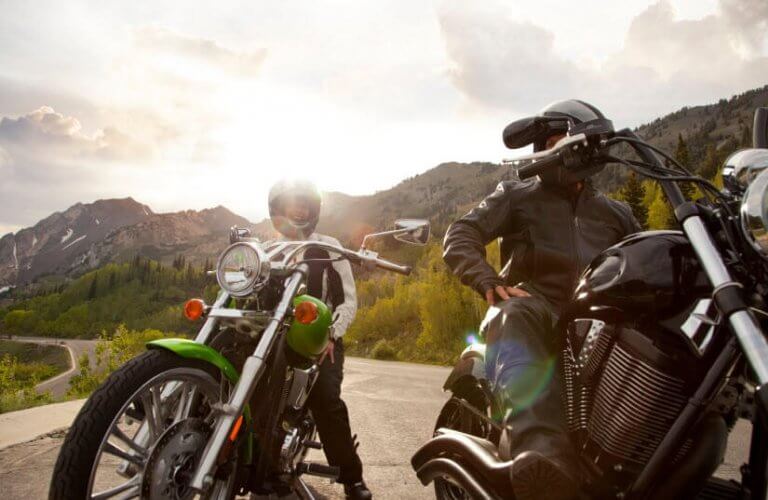
The history of the motorcycle is hardly straightforward, and depending on who you ask it can vary as much as the different options, coverage, and pricing for your motorcycle insurance. Although it’s not possible to identify a singular model or product as the “original” prototype there were many notable developments and inventions that we can attribute to the birth of the modern day motorcycle. All across Europe and from, even America, various inventions contributed to the engineering and design, that eventually evolved the “safety bicycle” to a steam-powered engine and ultimately to the gas-engine machines we recognize roaring across our freeways.
The mid- to late-1800s yielded the beginnings of features and innovations, that when brought together, resulted in what we now know as the modern motorcycle.
One of the most well-known prototypes, called the Roper steam velocipede, was a steam-powered version invented by Sylvester Howard Roper in 1867, who created a two-cylinder motorcycle powered by coal.
Although man-powered bicycles had been around, it wasn’t until 1885 that the most popular “safety bicycle” known as the Rover Safety gained wide recognition for its increased stability, ease of mounting, and reliable braking. What set it apart was that it featured two spoked wheels roughly the same size (30 inches in diameter), whereas the common bicycle at the time had a 48-inch front wheel and a 30-inch rear wheel, with a chain-driven rear wheel. Due to the low center of gravity, it offered more stability as well as direct front steering which improved control.
Later in that same year, Gottleib Daimler strapped an internal combustion engine on the easier to ride and control “safety bicycle” and created a motorized bicycle with a single-cylinder Otto-cycle engine (a new engine invented in 1876 by Nicolaus Otto, which was the first “Four-Stroke Internal Combustion Engine”) – the first gas-engine motorcycle. It had a wooden frame, wood spokes on the wheels and iron rims, and to increase stability, Daimler’s motorcycle had a spring-loaded outrigger wheel on each side. It was a rather rough and bumpy ride, so they were later nicknamed, “Bone Shakers.” Not the safest vehicle on the road, but no motorcycle insurance was required at the time.
Less than a decade later in 1892, Alex Millet added pneumatic tires and an upgraded five-cylinder rotary engine built into the rear wheel, versus being vertically strapped to the middle of a bicycle frame. And in Munich, Germany, a couple years later, the most successful motorcycle, the Hildebrand & Wolfmueller, had a parallel-twin engine that was cooled by water, meaning it required a water tank and radiator over the rear fender. Impressively, over 200 of these water-cooled motorcycles were being driven around Germany with no real records of motorcycle related accidents or injuries.
However, things would change when mass production became possible around 1895 (meaning people were riding them without motorcycle insurance or coverage for about half a century) when DeDion-Buton built a revolutionary high-revving four-stroke engine that was light and compact, but could still generate one-half horsepower.
DeDion-Buton’s engine was originally used on a motorcycle with three wheels, however, it was quickly adopted by most other manufacturers, and American production motorcycles were based off of his original design and concept. The two most famous American motorcycle manufacturers that benefited from the DeDion-Buton engine innovation were the Indian Motorcycle Company and Harley-Davidson.
The motorcycle became a reliable vehicle during wartime. American and European armies used them for everything, from message delivery to intelligence reconnaissance. About a third of all Harley-Davidson motorcycles that were sold went to the American military in 1917; by next year, Harley was selling half of all their bikes to the military, until it was estimated that the U.S. Army was employing about 20,000 motorcycles, mostly Harley-Davidsons. The Harley-Davidson brand became known for their strength, durability, and sturdy build, and by 1920, it was the largest motorcycle manufacturer in the world.
It wasn’t until after World War I, when automobiles began to dominate the roads that an emerging need arose for vehicle and motorcycle insurance as people realized that accidents left them bankrupt or in need of money to cover expenses, whether medical and injury-related or for property damage. As the number of motorcyclists rose over the decades, the types of insurance and coverage have also increased. In this day and age, you can conveniently shop online for quotes and to find out how much motorcycle insurance costs. A simple rule to follow when searching for the right motorcycle insurance coverage for you, make sure you get quotes from multiple insurance agencies, but remember to submit the same information in order to accurately compare quotes, coverage, and pricing.
Do you own a Harley? Feel free to share your thoughts in the comments section below.



